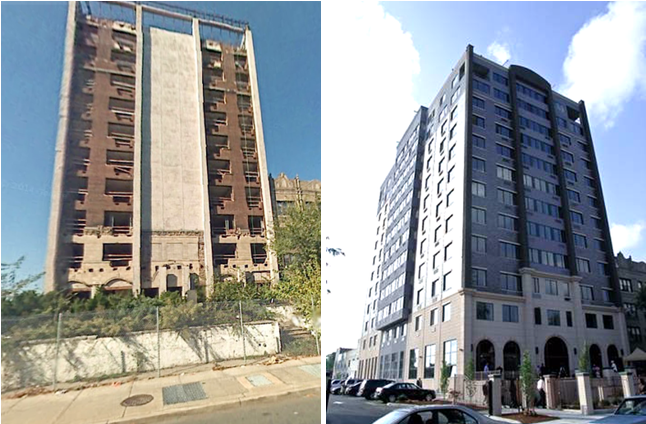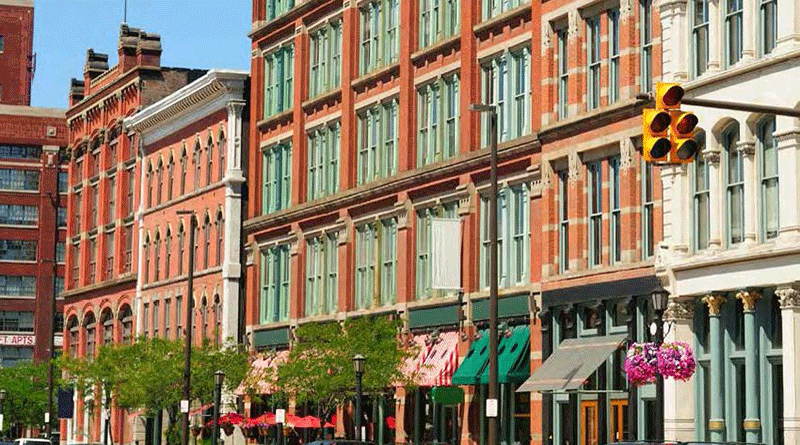Sounds like the start of a joke … what do old banks, churches, and hospitals have in common? Often the answer is great downtown locations that are close to transit stations and stops and architectural detail that is unlikely to be recreated. What these assets offer is the opportunity for adaptive reuse.
Adaptive reuse of buildings is a process that changes disused or ineffective structures in ways that allow them to be used for different purposes. Many New Jersey downtowns include buildings that no longer serve a useful purpose. Former banks, churches, hospitals – as well as schools, office buildings, and factories – stand unused or underutilized throughout the state. Despite their disuse, these structures often contribute to a community’s character and form strong elements within the urban fabric, and many have the potential to be put to productive use once again. When these structures are centrally located and/or near transit facilities, they can form the basis of adaptive reuse transit-oriented development (TOD).
Maintaining these kinds of properties as part of a transit-friendly redevelopment strategy provides communities a way to: 1) preserve their urban fabric, 2) realign land uses to meet current demands, 3) bring underperforming properties into more productive use, and 4) develop in an environmentally sensitive manner.
The greenest building is one that’s already built.
Carl Elephante, Director of Sustainability, Quinn Evans Architects
For developers and investors, adaptive reuse offers the opportunity to create unique projects that satisfy new users and that may also provide a return on investment.
According to the National Trust for Historic Preservation, building reuse nearly always offers environmental savings over demolition and new construction as the environmental payoff from a new, energy-efficient building can take between 10 and 80 years to recoup.
The Greenest Building: Quantifying the Environmental Value of Building Reuse, 2011
Changing Times
Changes in settlement patterns, living styles, and economic models mean that a variety of building types may be available for adaptive reuse. For example, changing demographics have led to the decommissioning of schools while changes in the health care and banking industries have placed a number of hospitals and banks on the real estate market. Similarly churches and former industrial buildings may be available due to shrinking congregations and less manufacturing.
Reimagining these spaces is often the first step toward the adaptive reuse of existing buildings. Having the vision that what was once a bank or a church could now be a shop or restaurant, a hotel or housing, or some combination of uses, is necessary to move these projects forward. Good candidates for adaptive reuse are buildings that no longer meet current demands due to demographic or economic changes, but offer location, aesthetic, and/or functional value. For example century-old school buildings may no longer be needed due to changing technology requirements or declining school enrollments, but their central locations, brick facades, and repetitive floorplans make them ideal for reuse as multifamily housing. Similarly, hospitals can be repurposed as apartments and condominiums or mixed use projects combining retail uses on the ground level with housing above.
Examples
Adaptive reuse often means capitalizing on the architectural elements offered by older structures. In downtown Montclair, the nearly complete reuse of a former bank illustrates this transformation. The Bravitas Group is converting the former Bank of Montclair building into class A office and retail space. The project retains many of the 1923 building’s original features including its exterior, original plaster moldings, and original bank vault that has inspired its new name – Vault491. Financing for the project includes the use of a 10% Federal Rehabilitation Investment Tax Credit, which is available for the rehabilitation of buildings that are not on the National Register of Historic Places. Completion of the project is planned for August 2016 and 85% of the space is already leased. The location is served by NJ TRANSIT 11, 28, 29, and 34 bus routes and sits within walking distance of the Walnut Street Station and the Bay Street Station on the Montclair-Boonton line. A municipal parking garage is located behind the building.

Buildings without historically desirable features may also provide opportunities for adaptive reuse. For example, repurposing old buildings may mean having structural elements in place at the start of construction, which can provide a financial benefit to the project overall. Redeveloping property in this manner can result in cost savings when pre-existing structure and other building systems are used and can make a project viable.

Indigo 141 in East Orange provides a good example of this kind of project. Completed in 2009, the project is the adaptive reuse of a former hotel located close to the Brick Church Station on NJ TRANSIT’s Morris and Essex Line. Stripped to its structural elements, the building’s skeleton formed the basis of a complete reworking of the building for residential use. The work resulted in 105 market rate apartments as well as a health club and child care facility. According to Patrick Terborg, TD + Partners Founder and Managing Member, utilizing the existing building frame allowed his firm to reduce construction costs and meet budgetary constraints.
Reutilizing an existing structure can cut project costs by as much as $10 a square foot. In an emerging market such as East Orange or Irvington, these savings can make or break a project”
Patrick Terborg, TD + Partners.
Planning and Collaboration
Communities can be proactive in their efforts and promote adaptive use in redevelopment planning. Jersey City, for example, has explicitly called for the adaptive reuse of former industrial buildings in its Garfield Avenue Redevelopment Plan. The plan details how the building fabric must be treated and specifies future uses for the structures. It calls for the restoration of building exteriors to original conditions, to the extent possible. Permitted uses in the Adaptive Reuse District include residential, live-work, and retail. See the Garfield Avenue Redevelopment Plan for more information.
Some communities promote adaptive reuse through a streamlined planning process. In 1999, Los Angeles adopted its Adaptive Reuse Ordinance, which established an expedited approval process and relaxed parking, density and other zoning requirements to provide flexibility in the approval and permitting process. This expedited process helps Los Angeles achieve its goal of stabilizing neighborhoods through efforts that preserve the city’s historic context, reduce environmental hazards and costs of new construction, and that enhance economic growth through new housing and employment opportunities.
To reimagine how public assets such as closed schools could be used in the future, communities should consider undertaking a comprehensive public process to plan for their sale, adaptation, or disposition. This was Philadelphia’s goal when faced with the closure of 23 public schools in 2013. The city brought together community members, private and nonprofit developers, city agencies, and local designers to determine community needs as well as the market for underutilized or disused properties. Involvement of stakeholders contributed to a plan for property use and allowed the city to move forward a process that aligned community expectations with economically feasible models for redevelopment. See Preservation Alliance for Greater Philadelphia or PIDC for more information.
Ultimately, successful adaptive reuse is more likely when there’s a good working relationship between public officials and the development community. Working closely with public officials, such as building and safety officials, fire marshals, and zoning administrators, can play an instrumental role in achieving code modification or relief from parking standards, setbacks, and other limitations on existing structures.
Getting It Done
Planning for and implementing adaptive reuse projects can be costly. One option for those seeking planning funds is Certified Local Government Historic Preservation Fund grants. The New Jersey Department of Environmental Protection, Natural & Historic Resources, Historic Preservation Office offers these grants to communities looking to identify and plan for the protection of historic resources.
While old buildings are often inexpensive to buy – and may have been unused for a long period of time – developers often face many challenges when bringing them back to productive use. Buildings will need to meet current building and fire codes. Renovations may be relatively minor or may require the wholesale replacement of building systems including heating, cooling, electrical, and plumbing. Environmental issues may also pose obstacles for reuse and may require the removal of lead paint and asbestos or the remediation of underground fuel storage or other environment concerns.
NJ Examples of Adaptive Reuse
Collingswood
The Old Zane School →
Kitchen & Associates (architecture firm)
East Orange
Hotel Suburban →
Indigo 141 (residential)
Jersey City
Joseph Dixon Crucible
Company (manufacturing) →
Dixon Mills (residential)
*
Jersey City Medical Center →
The Beacon (residential)
Montclair
Bank of Montclair →
Vault491 (office and retail)
Newark
Hahne & Co. (retail) →
Hahne Building (mixed-use:
residential, retail & education)
*
Second Presbyterian Church →
Audible, Inc. Headquarters (office)
Red Bank
First Church of Christ Scientist →
Two Eleven Broad (office)
Ridgewood
First National Bank & Trust Company →
FISH Urban Dining (restaurant)
Rutherford
Boiling Springs Bank →
Mason’s Cellar (retail)
Trenton
Broad Street Bank →
Broad Street Bank Apartments
The Federal Rehabilitation Investment Tax Credit (RITC) program encourages private investment in the rehabilitation and reuse of historic structures. This program is administered by the US Department of Interior (NPS with SHPO) and the Department of Treasury (IRS). A 20% tax credit is available for the rehabilitation and use of certified historic structures. To qualify a building must be used for income producing purposes such as office, commercial, or industrial uses or for rental housing. A 10% tax credit is available for the rehabilitation of non-residential buildings built before 1936. To qualify the building must be depreciable – office, commercial (including hotels), or industrial uses but not rental housing. Additional requirements are in place that specify the retention of existing building fabric. See National Park Service Technical Preservation Services for more information.
The NJ Redevelopment Authority offers a variety of financing opportunities that have been used to advance adaptive reuse projects. For example, the New Market Tax Credits have been used to help finance the redevelopment of the historic Hahne’s Department Store building in Newark that will be home to a Whole Foods supermarket. Other sources of financing for the project include funds from the NJ Housing and Mortgage Finance Agency, the NJ Economic Development Authority, and private equity.
Developers may also want to consider the NJ SmartStart program for support of improvements to a building’s exterior and systems that result in reduced energy usage.
TOD and Adaptive Reuse
Understanding the challenges and opportunities offered by adaptive reuse is helpful to communities looking to promote transit-friendly development. As can be seen in the projects in East Orange and Montclair, adaptive reuse can be an essential part of a transit-friendly redevelopment strategy. Like many adaptive reuse opportunities, Indigo 141 offers a great location while contributing once again to the urban landscape. Other projects like Vault491 in Montclair also capitalize on architectural styles and features that cannot be easily reproduced at the current time. Despite differences, both projects have allowed their respective communities a means of preserving their built assets and encouraging redevelopment near transit. Returning properties to the tax rolls contributes to the economic prosperity of the community. Encouraging new uses – those that satisfy present-day needs such as new housing and commercial space – can be one way of realigning the mix of land uses in downtowns. Understanding the interrelationship between community desires and the marketplace is a necessary step toward bringing underutilized properties back into productive use.

